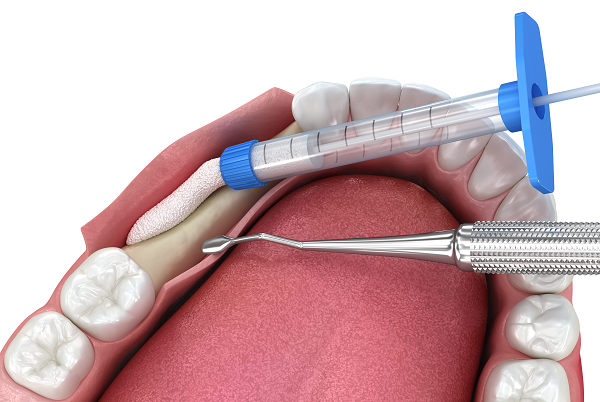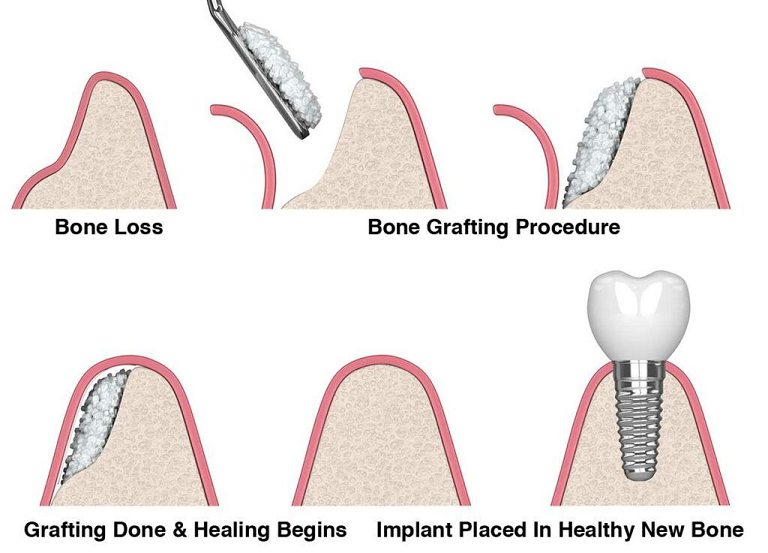Ridge Augmentation
Rebuild Your Smile with Ridge Augmentation:
Restoring the Foundation for Healthy, Beautiful Teeth
Have you experienced bone loss in your jaw due to tooth extraction, gum disease, or trauma? Ridge Augmentation is a specialized procedure designed to rebuild the natural contour of your jawbone, providing a strong foundation for dental implants and enhancing the aesthetics of your smile.
What Is Ridge Augmentation?
Ridge Augmentation is a surgical procedure aimed at restoring the natural contour and volume of the alveolar ridge, the part of the jawbone that supports your teeth. When a tooth is lost or extracted, the bone that once surrounded the tooth root can begin to deteriorate, leading to a sunken or irregular appearance in the jawline. This bone loss can make it difficult or even impossible to place dental implants, as there may not be enough bone structure to support them.
During a Ridge Augmentation procedure, bone graft material is added to the deficient area to rebuild and reshape the ridge. This grafting material stimulates new bone growth, restoring the natural contours of the jaw and creating a solid foundation for future dental implants or other restorative procedures. Ridge Augmentation not only improves the structural integrity of the jawbone but also enhances the overall aesthetics of your smile by correcting deformities in the jawline.

Why Choose Ridge Augmentation?
Ridge Augmentation offers several key benefits that make it an essential procedure for many patients:
Restores Jawbone Structure: The primary goal of Ridge Augmentation is to rebuild the lost bone in the jaw, restoring the natural shape and volume of the alveolar ridge. This is crucial for maintaining facial aesthetics and supporting future dental restorations.
Prepares for Dental Implants: By increasing the bone volume in areas where it has been lost, Ridge Augmentation provides a stable foundation for dental implants, ensuring their long-term success and durability.
Improves Aesthetic Appearance: Ridge Augmentation can correct irregularities and indentations in the jawline caused by bone loss, leading to a more natural and pleasing appearance.
Prevents Further Bone Loss: By addressing bone deficiencies early, Ridge Augmentation can help prevent further bone resorption and preserve the overall structure of the jaw.
Enhances Overall Oral Health: A strong, well-shaped jawbone is essential for maintaining the alignment of your teeth and preventing other oral health issues. Ridge Augmentation supports this by rebuilding and strengthening the jawbone.
The Ridge Augmentation Procedure: What to Expect
Ridge Augmentation is a precise and carefully planned procedure that involves the following steps:
1. Initial Consultation: Your journey begins with a thorough consultation, during which your oral surgeon will assess your oral health, take digital scans or X-rays, and discuss your goals and treatment options. This is also the time to ask any questions you may have and to develop a personalized treatment plan.

2. Preparation and Anesthesia: On the day of the procedure, local anesthesia will be administered to ensure your comfort. Sedation options may also be available if you prefer a more relaxed experience during surgery.
3. Surgical Exposure of the Ridge: Your surgeon will make an incision in the gum tissue to expose the area of the jawbone that requires augmentation. This allows for precise placement of the bone graft material.
4. Bone Grafting: Bone graft material is carefully placed into the area where the bone is deficient. This graft material may come from your own body (autograft), a donor (allograft), or a synthetic source. The grafting material is shaped and contoured to restore the natural ridge.

5. Stabilization and Suturing: Once the graft material is in place, it may be stabilized with special membranes or screws to ensure it remains secure during the healing process. The gum tissue is then sutured back in place.
6. Healing Period: After the procedure, a healing period of several months is required for the graft material to integrate with your natural bone. During this time, your dentist or oral surgeon will monitor your progress and provide specific care instructions to ensure successful healing.
7. Follow-Up Care and Dental Implants: Once the graft has fully integrated and the bone has healed, you can proceed with additional dental procedures, such as dental implants. Your surgeon will advise you on the optimal timing for this next step.
Rebuild Your Jawbone and Restore Your Smile with Ridge Augmentation
Ridge Augmentation is a crucial procedure for patients who have experienced bone loss in the jaw and are seeking to restore the natural contours and strength of their bone structure. Whether you’re preparing for dental implants or looking to improve the aesthetics of your smile, Ridge Augmentation provides the foundation for a successful, long-lasting restoration.
Contact us today at 302-273-8300 to schedule your consultation and learn more about how Ridge Augmentation can help you achieve the healthy, beautiful smile you deserve.

Frequently Ask Questions
How Do I Know If I Need Ridge Augmentation?
Your oral surgeon will determine if you need Ridge Augmentation based on a thorough evaluation of your oral health, including X-rays or 3D imaging. If there is insufficient bone in the jaw to support dental implants or if there are visible deformities in the jawline, Ridge Augmentation may be recommended.
Is the Ridge Augmentation Procedure Painful?
The procedure is performed under local anesthesia, so you should not feel pain during the surgery. Some discomfort, swelling, and minor bruising may occur after the procedure, but these symptoms can usually be managed with over-the-counter pain relievers and should subside within a few days.
How Long Does It Take to Heal After Ridge Augmentation?
The initial healing period usually takes a few weeks, but the bone graft material will take several months to fully integrate with your natural bone. In most cases, dental implants or other restorative procedures can be performed after 4 to 6 months, depending on the extent of the grafting and your body’s healing response.
What Materials Are Used for the Bone Graft in Ridge Augmentation?
The bone graft material used in Ridge Augmentation can come from various sources, including your own bone (autograft), donor bone (allograft), animal sources (xenograft), or synthetic materials. Your oral surgeon will recommend the best material based on your specific needs and medical history.
Are There Risks Associated with Ridge Augmentation?
As with any surgical procedure, there are risks, including infection, graft failure, or complications related to healing. However, these risks are relatively rare, especially when the procedure is performed by an experienced oral surgeon. Following post-operative care instructions carefully can help minimize these risks.
Can I Get Dental Implants Immediately After Ridge Augmentation?
In most cases, a healing period of several months is required after Ridge Augmentation before dental implants can be placed. This allows the graft material to fully integrate with your natural bone, providing a stable foundation for the implants.
How Do I Care for Myself After Ridge Augmentation?
After Ridge Augmentation, it’s important to follow your surgeon’s care instructions closely. This may include avoiding certain foods, keeping the area clean, and refraining from smoking. Regular follow-up visits will help ensure that the graft is healing properly.
Is Ridge Augmentation Covered by Insurance?
Coverage for Ridge Augmentation varies depending on your dental insurance plan and the specific circumstances of the procedure. Some plans may cover part of the cost if the procedure is deemed medically necessary for implant placement or other restorative work. It’s important to check with your insurance provider to understand your coverage and out-of-pocket costs.
What Is the Success Rate of Ridge Augmentation?
Ridge Augmentation has a high success rate, particularly when performed by an experienced oral surgeon. Success depends on factors such as the patient’s overall health, adherence to post-operative care instructions, and the quality of the bone graft material used.
